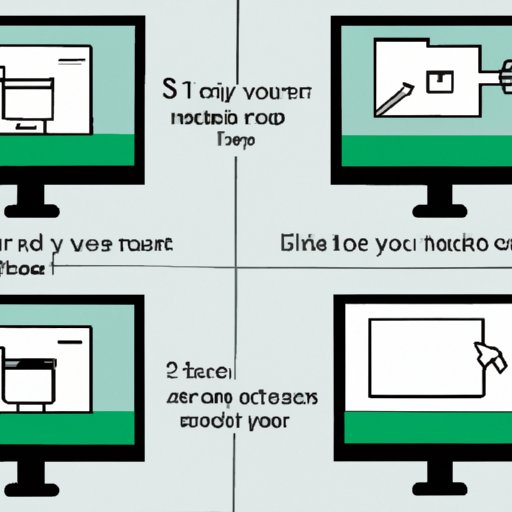Introduction
Whether you’re troubleshooting a technical issue, documenting a process, or simply sharing something funny or interesting, a screenshot can be an invaluable tool in your digital toolkit. Taking a screenshot allows you to capture an image of your computer or mobile device screen and save it for later use. But how exactly do you take a screenshot? And what are some tips and tricks for mastering the art of screenshots?

5 Simple Steps to Take a Screenshot on Your Computer
If you’re new to taking screenshots, the process may seem a bit daunting at first. However, the steps are actually quite straightforward:
- Identify the screen you want to capture: Whether you want to capture your entire desktop or just a specific window or section of the screen, it’s important to know exactly what you want to capture.
- Decide on the type of screenshot you want: Most computers offer several different types of screenshots, including full screen (capturing everything on your desktop), window (capturing a specific window or program), or selection (capturing a specific area of the screen).
- Use the keyboard shortcut or snipping tool to take the screenshot: Depending on your device, you can usually take a screenshot by pressing a specific key combination (such as Windows+PrtScn on Windows devices) or by using a built-in snipping tool (such as the Snipping Tool on Windows devices or Grab on Macs).
- Preview and save the screenshot: Once you’ve captured your screenshot, you can preview it to make sure it looks the way you want it to. If everything looks good, save the screenshot to your device.
- Edit or share the screenshot, if desired: If you want to make any changes to your screenshot (such as cropping or adding annotations), you can use an image editing tool like Paint or Photoshop. You can also share the screenshot with others by attaching it to an email, uploading it to a cloud storage service like Dropbox, or adding it to a note-taking app like Evernote.
Mastering the Art of Screenshots: Tips and Tricks
If you want to take your screenshots to the next level, there are plenty of tips and tricks to help you get there:
- Use third-party tools to create more detailed screenshots: While most devices offer built-in screenshot tools, there are also plenty of third-party apps and programs that can help you create more advanced screenshots, such as screen recordings or multiple screenshots stitched together into one image.
- Customize keyboard shortcuts for easy access: If you take a lot of screenshots, it can be helpful to customize the default keyboard shortcut so that it’s easier for you to remember and use. Many devices allow you to customize keyboard shortcuts in your settings.
- Use annotations and highlighter tools to make your screenshots more informative: If you’re using your screenshot for documentation or training purposes, adding annotations, arrows, or other visual aids can help make your screenshot more informative and useful.
- Use screenshots in conjunction with other tools, like image editors or video software: Taking screenshots is just one part of the process – you may also want to edit, annotate, or combine screenshots with other tools or media, such as video software or image editors.
From Mac to Windows: How to Take Screenshots on Any Device
While the basic process of taking a screenshot is similar across devices, there are some key differences depending on your operating system (OS) or device:
- Macs and macOS: On Macs, you can take a screenshot by pressing a combination of Command + Shift + 3 (for a full-screen shot) or Command + Shift + 4 (for a specific area of the screen). You can also use the built-in Grab tool for more advanced screenshots.
- Windows PCs and laptops: On Windows devices, you can take a screenshot by pressing a combination of Windows + PrtScn (for a full-screen shot) or Alt + PrtScn (for a specific window). You can also use the built-in Snipping Tool for more advanced screenshots.
- Mobile devices (iOS and Android): On most mobile devices, you can take a screenshot by pressing a combination of the power button and the home button (on older iOS devices) or the power button and volume-down button (on newer iOS devices and most Android devices).
How to Capture a Screenshot and Save it for Later
Of course, taking the screenshot is just the first step – you also need to save it in a way that’s easy to access and use later. Some options include:
- Saving screenshots as image files: Once you’ve taken your screenshot, you may want to save it as an image file (such as a PNG or JPG) so you can easily access and share it later.
- Uploading screenshots to cloud storage or note-taking apps: If you’re working on a project that requires multiple screenshots, it can be helpful to upload them to a cloud storage service (such as Dropbox or Google Drive) or a note-taking app (such as Evernote or OneNote).
- Using screenshots for documentation or troubleshooting purposes: Finally, screenshots can be an invaluable tool when it comes to documenting or troubleshooting issues, whether you’re working on your own device or helping someone else troubleshoot a problem.
Screenshots 101: An Easy Guide to Capturing Your Screen
If you’re just starting out with screenshots, here are a few key concepts to keep in mind:
- Understanding the different components of a computer or mobile device screen: Knowing the difference between your desktop, Dock/Taskbar, and menu bar can help you identify what you need to capture in your screenshot.
- Identifying the different types of screenshots and when to use each one: Depending on what you’re trying to capture, you may want to use a full-screen shot, window shot, or selection shot.
- Explaining basic concepts like resolution, file format, and aspect ratio: These terms may seem confusing at first, but understanding them can help you create screenshots that are clear, high-quality, and easy to share.
Making Your Life Easier: The Benefits of Knowing How to Take Screenshots
So, why bother learning how to take screenshots in the first place? Here are just a few of the benefits:
- Saving time when troubleshooting or documenting issues: Instead of trying to explain a problem in words, you can simply take a screenshot and share it with others to help them understand what you’re seeing.
- Enhancing communication by sharing visual aids with others: Whether you’re trying to teach someone how to use a specific feature or simply sharing something interesting, a screenshot can be a quick and effective way to communicate your message.
- Enabling users to create their own tutorials or how-to guides: If you’re trying to teach someone how to use a specific program or do a specific task, a screenshot can be a great way to illustrate your instructions.
Conclusion
Taking screenshots may seem like a simple task, but it can have a big impact on your digital life. Whether you’re a seasoned pro or just starting out, knowing how to take screenshots can save you time, enhance communication, and help you troubleshoot issues more effectively.
